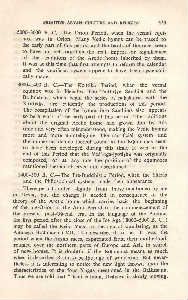Page 592 - Lokmanya Tilak Samagra (khand 2)
P. 592
PRIMITIVE ARYAN CULTURE AND RELIGION 373
5000-3000 B. C.-The Orion Period, when the vernal equi-
nox was in Orion. Many Vedic hymns can be traced to
the early part of this period and the bards of the race seem
to have not yet forgotten the real import or significance
of the traditions of the Arctic home inherited by them.
It was at this time that first attempts to reform the calendar
and the sacrificial system appear to have been systemati-
cally made.
3000-1400 B. C.-The Kpttika Period, when the vernal
equinox was in Pleiades. The Taittinya Samhita and the
Bn1hma~as, which begin the series of nak~hatras with the
Krittikas, are evidently the productions of this period.
The compilation of the hymns into Samhitas also appears
to be a work of the early part of this period. The traditions
about the original Arctic home had grown dim by this
time and very often misunderstood, making the Vedic hymns
more and more unintelligible. The sacrificial system and
the numerous details thereof found in the Brahma~as seem
to have been developed during this time. It was at the
end of this Period that the Veda~ga-jyoti~ha was originally
composed, or at any rate the position of the equinoxes
mentioned therein observed and ascertained.
1400-500 B. C.-The Pre-Buddhistic Period, when the Sutras
and the Philosophical systems made their appearance.
These periods differ slightly from those mentioned by me
in Orion; but the change is needed in consequence of the
theory of the Arctic home which carries back the beginning
of the pre-Orion or the Aditi Period to the commenccement of
the present post-Glacial era. In the language of the Pun1pas
the first period after the close of the Ice Age ( 8000-5000 B. C. )
may be called the Krita Yuga or the age of wandering, as the
Aitareya Bn1hmapa ( VII, 15 ) describes it to be. It was the
period when the Aryan races, expatriated from their motherland.
roarp.ed over the northern parts of Europe and Asia in search
of ne~ homes. It is doubtful if the Bn1hmapa meant as much
when it described Kpta to be t):le __ age of wandering. But never-
theless it is interesting to notice the · new light thrown upon the
characteristics of the four Yugas mentioned in tb,e Brahma~a.
Thus we are told that " Kali is lying, Dviipara i.s slowly moving,

